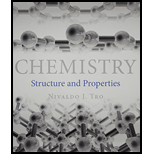
Concept explainers
Which set of elements is arranged in order of increasing electro negativity?

Interpretation:
The correct set of elements arranged in increasing order of electronegativity should be determined.
Concept introduction:
Electronegativity is a chemical property of elements, due to which an atom has the tendency to attract shared pair of electrons towards itself. This results in unequal distribution of electrons in bond.
Correct answer: Option (c)
Explanation of Solution
Reason for correct answer:
In the modern periodic table, elements are arranged in order of their increasing atomic number. For this reason, along a period, more and more electrons are added from left to right. As a result, the distance between the nucleus and valence electrons decreases. This increases the electronegativity.
However, down the groups, more and more electronic shells are added due to increase in atomic numbers. As a result, the distance between the nucleus and valence electrons increases. For this reason, electronegativity decreases down the group.
The electronegativity of germanium is 2.01
The electronegativity of arsenic is 2.18
The electronegativity of sulfur is 2.58
The electronegativity of oxygen is 3.44
The electronegativity values are in increasing order in option (c) only. Hence option (c) is found as the correct option and options (a), (b) and (d) is found to be wrong answers.
Want to see more full solutions like this?
Chapter 6 Solutions
Chemistry: Structure and Properties & Modified MasteringChemistry with Pearson eText -- ValuePack Access Card -- for Chemistry: Structure and Properties Package
- Compare the properties of an ionic material such as sodium chloride with a room-temperature ionic liquid. Explain this difference.arrow_forwardIn each of the following groups, which element is the most electronegative? Which is the least electronegative? msp;a.K,Na,Hb.F,Br,Nac.B,N,Farrow_forwardWhy do nonmetals tend to form anions rather than cations?arrow_forward
- Relate the atomic structure of osmium (Os) to its electronegativity, ionization energy, and ionic radius.arrow_forwardDoes the periodic trend of electronegativity match the periodic trend of ionization energy?arrow_forwardFor the group 6A elements, what is the trend in electronegativitywith increasing atomic number?arrow_forward
- How many electrons will beryllium need to be removed in order for it to become a stable ion?arrow_forwardWhy can dissolved ionic compounds conduct an electric current but dissolved covalent compounds cannot?arrow_forwardGive 6 ions that are isoelectronic with neon . Place these ions innorder of increase sizearrow_forward
- Of the elements Li, K, N, P, and Ne, which (a) is the most electronegative, (b) has the greatest metallic character, (c) can bond tomore than four atoms in a molecule, and (d) forms π bonds most readily?arrow_forwardWhy are elements at the extreme left and extreme right the most reactive?arrow_forwardWhy does the ionization enthalpy gradually decreases in a group?arrow_forward
 Introductory Chemistry: A FoundationChemistryISBN:9781337399425Author:Steven S. Zumdahl, Donald J. DeCostePublisher:Cengage Learning
Introductory Chemistry: A FoundationChemistryISBN:9781337399425Author:Steven S. Zumdahl, Donald J. DeCostePublisher:Cengage Learning Chemistry for Engineering StudentsChemistryISBN:9781337398909Author:Lawrence S. Brown, Tom HolmePublisher:Cengage LearningChemistry: Matter and ChangeChemistryISBN:9780078746376Author:Dinah Zike, Laurel Dingrando, Nicholas Hainen, Cheryl WistromPublisher:Glencoe/McGraw-Hill School Pub Co
Chemistry for Engineering StudentsChemistryISBN:9781337398909Author:Lawrence S. Brown, Tom HolmePublisher:Cengage LearningChemistry: Matter and ChangeChemistryISBN:9780078746376Author:Dinah Zike, Laurel Dingrando, Nicholas Hainen, Cheryl WistromPublisher:Glencoe/McGraw-Hill School Pub Co General Chemistry - Standalone book (MindTap Cour...ChemistryISBN:9781305580343Author:Steven D. Gammon, Ebbing, Darrell Ebbing, Steven D., Darrell; Gammon, Darrell Ebbing; Steven D. Gammon, Darrell D.; Gammon, Ebbing; Steven D. Gammon; DarrellPublisher:Cengage Learning
General Chemistry - Standalone book (MindTap Cour...ChemistryISBN:9781305580343Author:Steven D. Gammon, Ebbing, Darrell Ebbing, Steven D., Darrell; Gammon, Darrell Ebbing; Steven D. Gammon, Darrell D.; Gammon, Ebbing; Steven D. Gammon; DarrellPublisher:Cengage Learning Chemistry: Principles and PracticeChemistryISBN:9780534420123Author:Daniel L. Reger, Scott R. Goode, David W. Ball, Edward MercerPublisher:Cengage Learning
Chemistry: Principles and PracticeChemistryISBN:9780534420123Author:Daniel L. Reger, Scott R. Goode, David W. Ball, Edward MercerPublisher:Cengage Learning




